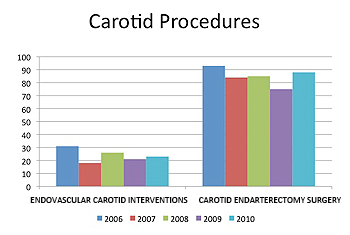Montefiore Einstein Center for Heart and Vascular Care – Vascular and Endovascular Surgery - Carotid Artery Stenois - New York
Strokes affect more than 500,000 people in the U.S. each year. Carotid artery stenosis - narrowing of the main arteries in the neck - is a major cause of these strokes. In these situations plaque build up inside the artery, causing it to narrow. The plaque itself may have irregular edges allowing clots to form on the plaque, which can then travel to the brain, blocking smaller, but important arteries that supply blood to the brain. The result can be either a Transient Ischemic Attack (TIA), also called a "mini-stroke" or a major stroke. In a TIA the symptoms are temporary and may resolve in a few seconds, minutes or hours. In either case these are a warning sign and require medical attention. Symptoms associated with a TIA or stroke include: loss of sensation or weakness in one arm or leg, or one side of the body, but not the other; trouble with vision in one eye, like a shade coming down over the eye; drooping of one side of the face; trouble speaking or understanding speech, etc.
Diagnosis of Carotid Artery Stenosis
Carotid artery narrowing may be suspected on physical exam by listening over the neck. If a bruit "noise" is heard, carotid artery narrowing may be present. Other tests that can detect carotid narrowing are ultrasound, CT scanning, MRI scanning, and angiography.
Treatment Options
Carotid endarterectomy is a procedure which removes plaque from the artery reducing the risk of stroke. In this procedure the plaque is carefully removed from the artery. Our surgeons excel at this time-tested and durable procedure, which remains the gold standard treatment for carotid artery disease.

For patients whose health or anatomic considerations prohibits open surgery, we offer carotid artery stenting with brain protection. Montefiore was among the first in the nation to perform this procedure, which patients undergo without the need for general anesthesia or incisions. A metallic stent is inserted into the narrowed carotid artery and expanded, displacing and trapping the plaque, while a filter captures any particles released, reducing the risk of stroke.
- Clinical Cardiology
- Diseases and Conditions
-
Services and Treatments
- Montefiore Advanced Lung Disease Program
- The James Scheuer, MD Division of Cardiology
- Diagnostic Tests for Heart and Vascular Disease
-
Treatments/Procedures for Heart and Vascular Disease
- Pacemaker
- Implantable Cardioverter Defibrillator
- Ablation
- Interventional Cardiology
-
Surgical Services
- Aortic Valve Surgery
- Aortic Valve Sparing Surgery
- Adult Congenital Heart Disease
- Aneurysm Surgery
- Heart Transplant
- Atrial Fibrillation Surgery
- Coronary Artery Bypass Surgery (CABG)
- Hybrid Revascularization
- Mechanical Heart Devices (LVADs)
- Minimally Invasive and Robotic Cardiothoracic Surgery
- Mitral Valve Repair and Replacement
- Pediatric Congenital Heart Surgery
- Robotic Heart Surgery
- Stem Cell Therapies
- Total Artificial Heart
- Transcatheter Aortic Valve Replacement (TAVR)
- Transmyocardial Revascularization (TMR)
- Vascular and Endovascular Surgery
- Ventricular Remodeling Surgery (SVR)
- Support Services for Heart and Vascular Disease
- Transcatheter Aortic Valve Replacement (TAVR)
- Cardiothoracic and Vascular Surgery
- Comprehensive Heart Valve Repair Program
- Tarrytown Cardiology Associates
- Bronx Medical Cardiac
- New Rochelle Cardiology
- Montefiore Einstein Pulmonary Hypertension Program
- Heart and Vascular Disease Prevention and Wellness
- Research and Clinical Trials
- About Us
- Education
- Contact
- Support the Heart and Vascular Center


